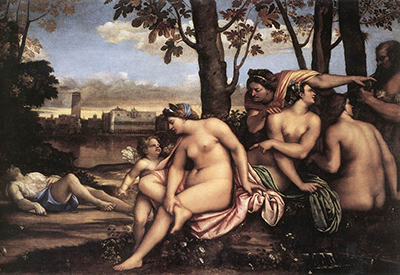Death of Adonis is dated 1511-1512, making this perhaps Sebastiano del Piombo's first painting after ceasing work on his huge Judgement of Solomon mural. It can now be found in the Uffizi Gallery in Florence.
This painting oozes the influence of Giorgione from every pore, most of all in the landscape scene which sits in the background. Sebastiano was still relatively young at this point and very much a product of the Venetian school of art which also gifted us the likes of Titian, Tintoretto, Paolo Veronese and Lorenzo Lotto.
The artist separates this scene into two key parts, with the foreground sweeping in from the right and the background from the left. Multiple figures are strewn across the compsition, allowing the artist to display his figurative skills. Purely landscape paintings were very rare during this part of the Renaissance and here the touches of nature are intended as a support to his female portraits who lie closest to the viewer.
The painting would come under the ownership of the Uffizi in 1798 after being gifted it from those who had it passed on from Cardinal Leopoldo de Medici around a century earlier. There is a surprising inclusion of antiquity considering that the artist had not been living in Rome for long before undertaking this painting. There are influences from both Michelangelo and Raphael here, too, despite their personal disliking for each other.
The Uffizi Gallery understandably displays this painting under its Italian name of Morte di Adone. It hols its own within the gallery's extensive collection with is not an easy feat when placed against work by the likes of Michelangelo (who has his own floor), Rembrandt, Caravaggio, Leonardo da Vinci, Lorenzo Lotto and Raphael. This prestigious venue is amongst the biggest draws in the art world, drawing thousands of visitors to Florence every year.
Sebastiano del Piombo was eventually to become the most famous artist in Rome once his style had cemented the styles of his birthplace of Venice with his new home in the capital. At that point he was at the front of the queue for all major commissions and he could also exert significant influence over projects budgets, preferred assistants and the artistic direction. He never had much of a studio himself and perhaps that is the main reason for why his career is not placed at quite the same level as some other members of the Venetian school.




